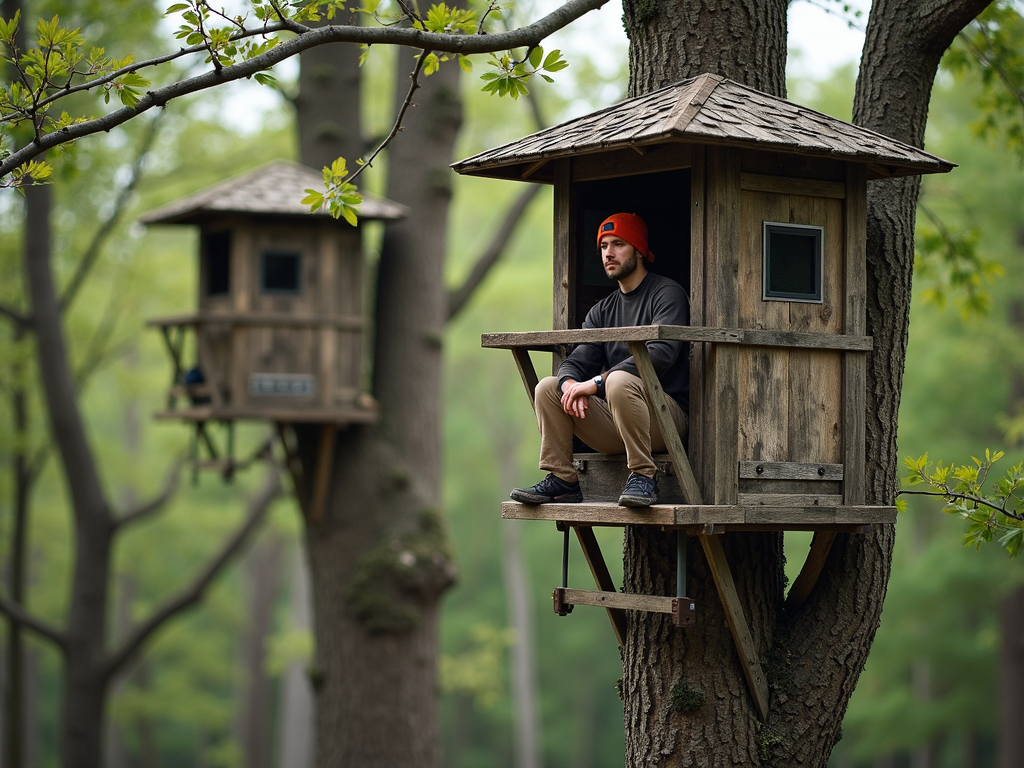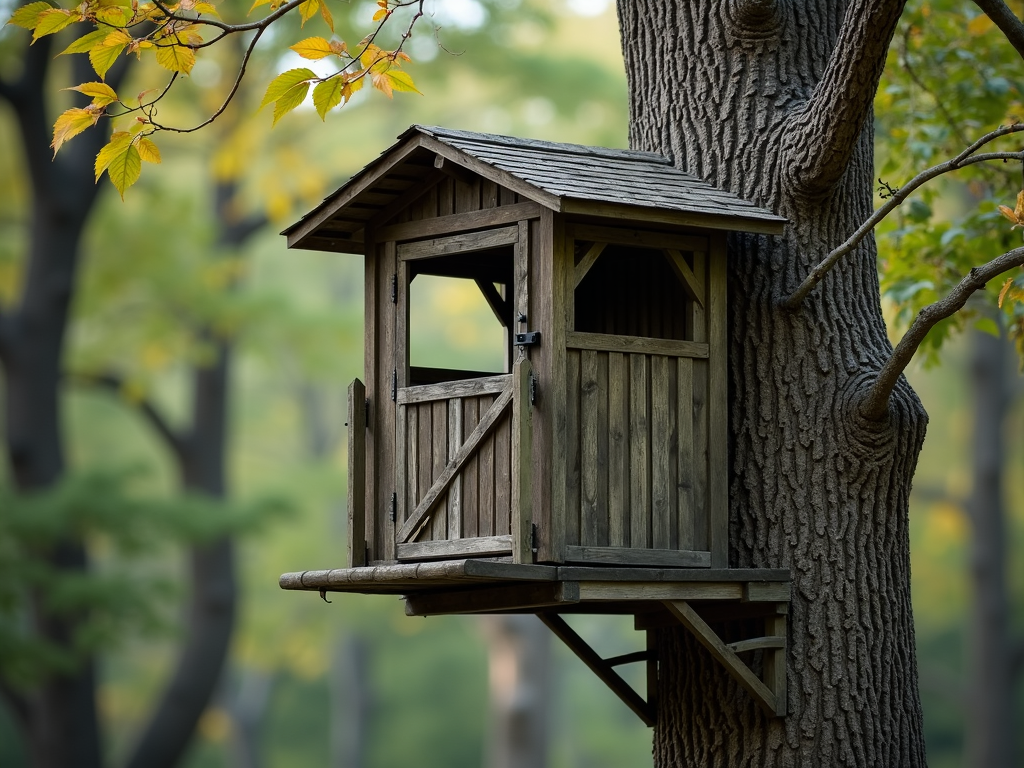Here’s something that’ll make you rethink everything about hunting from tree stands.
While everyone else is sitting in their blind hoping a deer walks by, smart hunters are getting text messages about incoming bucks 300 yards out. Yeah, you read that right.

The game has changed. Most hunters don’t even know it yet.
See, tree stand blinds used to be simple concealment boxes. You’d climb up, sit down, and wait. Maybe you’d get lucky. Maybe you’d freeze your butt off for nothing.
But in 2025, the best tree stand blinds aren’t just hiding spots anymore. They’re command centers.
Technology integration is transforming success rates in ways that would’ve seemed like science fiction just five years ago. Wisconsin bowhunter Jake Thornton went from seeing deer “sometimes” to predicting their movements with 73% accuracy.
His secret? He stopped thinking of his tree stand blind as furniture. Started treating it as a platform for intelligent hunting.
This isn’t about throwing gadgets at the problem. It’s about understanding how modern tree stand blinds can work with technology to create a hunting system that works even when you’re not there.
The Evolution of Tree Stand Blinds: From Basic Concealment to Smart Hunting Hubs
Let me blow your mind real quick.
The new Barronett Blinds Ovation model comes with built-in camera mounting systems and view-through fabric designed specifically for electronic devices. This isn’t your grandpa’s tree stand blind anymore.
Companies like Ameristep and Summit Treestands finally figured out what hunters actually need. Not just walls to hide behind, but platforms that integrate with the tools we’re already using.
Think about it. Every serious hunter has trail cameras. Most have multiple cameras.

But until recently, mounting them effectively near your tree stand blind was a pain in the ass. You’d jerry-rig some sketchy setup that probably spooked more deer than it photographed.
Now? These blinds come ready for tech integration.
The thermoplastic polyurethane frames aren’t just lightweight tree stand blinds anymore. They’re designed with reinforced mounting points that won’t vibrate or shift when your cameras activate.
Muddy Outdoors took it even further. Their elevated hunting blinds now feature silent window mechanisms that work perfectly with motion-triggered recording devices. No more choosing between opening windows for visibility and keeping them closed for concealment.
The 300D fabric on modern portable tree stand blinds isn’t just about being waterproof tree stand blinds anymore. Manufacturers discovered that certain fabric densities actually improve wireless signal transmission. Your cellular trail cameras get better reception through these materials than through traditional blind walls.
Here’s the kicker – this evolution happened because hunters demanded it. We stopped accepting “good enough” and started asking why our tree stand blinds couldn’t do more.
The industry listened.
But having the right blind is only half the story. The real magic happens when you understand how to position your technology for maximum effectiveness.
Strategic Technology Integration: The Triangle Coverage Method That Changes Everything
Jake Thornton’s story will change how you think about tree stand blind setup forever.
This Wisconsin bowhunter increased his whitetail deer encounters by 215% using a three-camera perimeter system around his Ameristep blind. Not luck. Strategy.
Here’s what most hunters screw up – they mount cameras randomly, hoping to catch something.
Thornton uses what he calls the Triangle Coverage Method. Picture this: your tree stand blind sits at the center of an imaginary triangle. Each point of that triangle, roughly 50-75 yards out, gets a cellular trail camera.
But here’s the genius part. The cameras face inward, toward your blind, not outward.
This creates overlapping coverage zones where deer can’t move without triggering multiple angles. You’re not just seeing deer. You’re seeing their behavior patterns, their comfort levels, their exact routes.
The tree stand blind height matters too. Forget what you’ve heard about mounting cameras as high as possible. Data shows 15-20 foot heights optimize both coverage and wireless connectivity while maintaining stealth. Any higher and you’re just making tree stand blind installation harder and signal strength weaker.
Motion sensors add another layer. Thornton runs wireless motion detectors at ground level between his cameras and blind. These don’t take pictures. They just alert his phone when something breaks the perimeter.
By the time a deer reaches camera range, he already knows it’s coming.
The real-time alerts change everything. Instead of checking SD cards after your hunt, you’re getting notifications while you’re at work, eating dinner, sleeping. You start seeing patterns. Tuesday mornings at 7:15. Thursday evenings just before dark.
Suddenly, you’re not guessing when to hunt during hunting season.
The power solution matters more than you think. Solar panels with lithium battery backups keep everything running season-long. No more dead cameras at crucial moments. Thornton uses 20-watt panels positioned for maximum southern exposure, even in heavy timber.
Of course, all this technology means nothing if you make the common mistakes that send deer running before you even climb into your stand.
Common Integration Mistakes That Sabotage Your Hunt (And How to Avoid Them)
Here’s a truth bomb – 67% of hunters screw up their tech integration in the first season.
Not because they’re dumb. Because nobody talks about what actually goes wrong.
Let’s fix that.
Mistake number one: mounting cameras directly on your tree stand blind. Seems logical, right?
Wrong.
Every time you climb up, you’re shaking the entire structure. Cameras shift. Angles change. Worse, deer associate the blind movement with danger. Mount cameras on separate trees or use ground-based tripods with stabilizing stakes.
Mistake two kills more hunts than anything – ignoring scent control on your tech.
Those cameras and solar panels you installed? They reek of human scent. Deer smell the plastic, the metal, the batteries. Smart hunters wear gloves during installation and spray everything with scent eliminators. Some even leave equipment outside for weeks before season to let it naturalize.
The third mistake is pure stupidity, but everyone does it. They buy waterproof tree stand blinds then drill holes for cable runs.
Congratulations, you just voided your weatherproofing.
Use the pre-made ports or external mounting systems. Your expensive electronics will thank you when that unexpected storm rolls through.
Mistake four: over-teching your setup. More cameras doesn’t mean more deer. It means more failure points, more batteries to die, more things to malfunction. Start with three cameras max. Master that system before expanding.
The fifth mistake might surprise you – mounting heights for tree stand blind safety.
Higher isn’t always better. Yeah, 30 feet gives you visibility, but it also puts you above effective bow hunting tree stand blinds range and makes your technology integration a nightmare. Stay between 15-20 feet for the optimal balance of concealment, shot angles, and tech functionality.
Now here’s something else. The whole tree stand vs ground blind debate? Technology ends it.
Pop up tree stand blinds with proper tech integration blow ground blinds away for one simple reason – elevation gives your wireless signals clear transmission paths. Ground blinds struggle with connectivity in thick cover.
Now let’s put it all together with a system that actually works in the real world.
Building Your Smart Hunting System: A Step-by-Step Approach
You’ve got a choice to make.
Keep doing what everyone else does – climb into your tree stand blind and hope for the best. Or join the hunters who are leveraging technology to stack the odds in their favor.
The transformation from passive waiting to active hunting doesn’t happen overnight. But it starts with one simple step.
Add a single cellular trail camera to your existing setup this week. Just one.
Learn how it changes your understanding of deer movement around your stand. Once you see those patterns, you’ll never hunt blind again.
Start with budget tree stand blinds if you need to. Even basic models work with proper tech integration. The Primos Hunting Double Bull series offers solid starting points without breaking the bank.
As you expand, focus on tree stand blind accessories that actually matter. Camera mounts. Solar panels. Wireless signal boosters.
Skip the fancy camouflage tree stand blinds patterns and invest in technology infrastructure instead. A plain blind with good cameras beats a $2000 blind with no intel every single time.
For rifle hunting setups, extend your triangle coverage to 100-150 yards. The longer shot opportunities mean you need earlier warning systems.
The tree stand blind windows matter more than you think. Get models with multiple shooting ports and silent adjustment mechanisms. When that big buck shows up on your phone alert, you want options for shot placement without movement.
Remember those tree stand blind kits that include “everything you need”? They don’t. Not anymore.
Modern hunting requires treating your blind as part of a larger system. The blind provides concealment and shooting platform. Technology provides intelligence and prediction.
Combine them right, and you’re not hunting anymore. You’re executing a plan based on data.
Conclusion: The Future of Hunting Is Already Here
As smart hunting technology evolves, the gap between tech-savvy hunters and traditional “hope and wait” hunters will only grow wider.
The hunters building data now, learning these systems, understanding these patterns – they’re creating advantages that compound every season.
Your tree stand blind doesn’t have to be just a hiding spot anymore. It can be your hunting intelligence hub.
The question isn’t whether to integrate technology. It’s whether you’ll do it right, starting now, or play catch-up later while others are filling their tags.
Those all season tree stand blinds you’ve been eyeing? They’re worthless without a plan to make them work smarter, not just harder.
The best deer hunting blinds in 2025 aren’t the most expensive ones. They’re the ones integrated into intelligent hunting systems.
Jake Thornton’s 215% increase in deer encounters? That’s not an outlier anymore.
That’s the new baseline for hunters who get it.
The rest? They’re still sitting in their blinds, hoping something walks by.
Which hunter do you want to be?